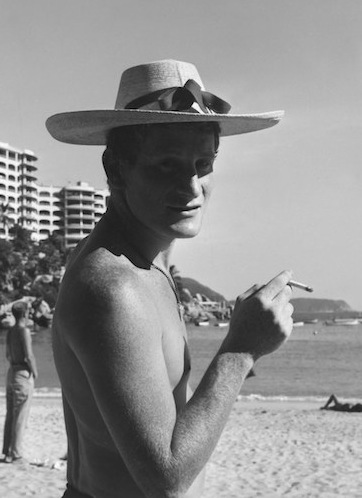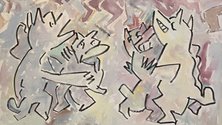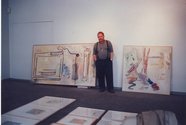Andrew Paul Wood – 21 September, 2015
In the 70s the family decamped to Mexico for a period where the artist became entranced by the country's rich culture and ancient traditions. It adds considerably to the documentary that Horrocks goes to Mexico to interview family and get a sense of the atmosphere. It is here that we learn the dancing dogs that feature in a number of works are based on an Aztec motif of the hairless Mexican dogs that the Aztecs bred to warm their feet in winter and eat in the spring.
Shirley Horrocks
Tom Who? The Enigma of Tom Kreisler
73 mins
Producer: Shirley Horrocks, Tony Green
Photography: Adrian Greshoff, Leon Narby, Ron Egozi
Editor: Steven Mountjoy
Narrator: Jennifer Ward Lealand
Initially, in the past, I must admit to having been somewhat skeptical about the work of Tom Kreisler (1938-2002). He didn’t fit tidily into the accepted tropes of New Zealand art history. His themes were altogether too whimsical, hermetic and idiosyncratic to seem more than a curiosity. Far too much colour and cartoonishness. But as I slowly came to realise, the humour was in fact dryer than it at first appeared, the whimsy implying a profound and existential seriousness beneath the bright palette and magpie-snaffled trifles.
Shirley Horrocks‘ feature-length documentary Tom Who?, premiering at the 2015 New Zealand International Film Festival, sealed the deal. The Horrocks name has cemented itself as something of a cultural dynasty, and Shirley is well known and respected for her documentaries on the likes of Marti Friedlander, Albert Wendt and Len Lye, very often figures whose position to the local narrative are complex and not always safely canonical. The title alludes to Kreisler’s marginal status in New Zealand, known by the people that matter but not as celebrated as he should be.
Kreisler spent the early part of his life growing up in Buenos Aires, son of Viennese Jews who had fled the Nazis, and sent thence to New Zealand in the early 1950s at the age of thirteen to live with his uncle and aunt (architect Ian Athfield was a boyhood friend). Unsurprisingly much of the documentary is punctuated by tango music, which may also hint at the Jewish origins he was always rather coy about, by way of the infamous prisoner tango orchestras of the death camps. Perhaps too a hint of that uniquely Argentine emotion mufarse - an impossible to translate bitter and melancholic introspection.
What the documentary conveys so well, which art historical texts do not, is the importance of Kreisler‘s relationship with other people, graduating with honours in painting from the University of Canterbury School of Fine Arts where his contemporaries included Dick Frizzell and John Coley, taught by Rudi Gopas and Bill Sutton. In his first dealer show, he embraced the entirely foreign spirit of Pop Art with typically subversive wit, ruthlessly satirising the Arts Council 1967 tour of a replica of Michelangelo’s David by exhibiting gesturally-painted close-ups of various parts of the statue, most notably one of the most famous penises in Western art history.
In 1968 Kreisler went with his wife, Lesley, to teach art at New Plymouth Boys’ High School, cutting an eccentric dash in the provinces with his accent and burden of culture. One of the attractions of New Plymouth was the then new Govett-Brewster, dear old G-BAG, which was a relatively radical and innovative gallery environment for New Zealand in the day and with which the Kreislers were closely involved. Kreisler also taught for many years at the local polytechnic, influencing many artists. They would also go on to bolster New Plymouth’s art scene when they established the Lesley Kreisler Gallery in 1990. For the most part, though they preferred to stay out of art world politics.
Artistically he stands out for his, as the Italians say, sprezzatura - a contrived lightness of touch that conceals its careful artifice, and his refusal to indulge treating a Victorian-Romantic-derived tradition of landscape painting as the basis of some kind of therapy, as was the accepted norm in New Zealand art. In a way perhaps he is a kind of tupuna for and part of the intellectual whakapapa of Michael Parekowhai and Peter Robinson who are likewise darkly humorous and playfully intellectual. At the time it was art that was definitely more New York than New Zealand even if Kreisler was as far away from what was going on as anybody else.
In the 70s the family decamped to Mexico for a period - Kreisler‘s typical quixotic impulsiveness after a visit to his ailing mother who was living there - where the artist became entranced by the country’s rich culture and ancient traditions, notably the Día de Muertos/Day of the Dead harvest festival with its decorative skeletons and roots going back to the days of the Aztecs. It adds considerably to the documentary that Horrocks goes to Mexico to interview family and get a sense of the atmosphere. It is here that we learn the dancing dogs that feature in a number of works are based on an Aztec motif of the hairless Mexican dogs that the Aztecs bred to warm their feet in winter and eat in the spring. These dogs become surrogates for the artist’s thoughts in a way that reminds me of Reg Mombasa.
One of the other highlights for me was Wystan Curnow’s discussion of Kreisler’s weather map paintings, which are a personal favourite of mine, as are the coat works and their inescapable kinship with Jim Dine’s dressing gowns (a point I don’t recall being picked up on in the film).
Later in life Kreisler suffered from poor health, high blood pressure and severe asthma, and in the last works before his untimely passing an awareness of death creeps into the paintings, perhaps an echo of the matter-of-fact, intimate and personal relationship with death he found in Mexican culture. He was only 63 when he died, leaving us to wonder what might have been.
Horrocks’ documentary has created a very watchable immersion into this complex man and his work. If I have a minor cavil it is, perhaps, that given Kreisler’s relative obscurity it would have been nice to have had slightly more attention on the work, and slightly less of the various family, friends, art worlders and former students who obviously all adored him, but frequently seem to all be pretty much repeating each other a lot of the time. Otherwise it’s a great and highly informative record of the life of an artist deserving far more attention (even now) than he has had.
Andrew Paul Wood





 Two Rooms presents a program of residencies and projects
Two Rooms presents a program of residencies and projects Advertising in this column
Advertising in this column



This Discussion has 0 comments.
Comment
Participate
Register to Participate.
Sign in
Sign in to an existing account.